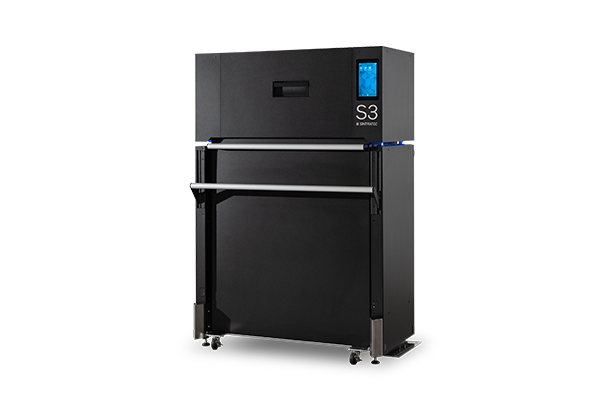The 3D Printing Industry Awards 2022 shortlists are now available for voting. Who will win the 2022 3DPI Awards? Have your say by casting your vote now.
Selective Laser Sintering (SLS) 3D printer manufacturer Sintratec has launched a new all-in-one production system at the Formnext trade show.
Composed of modular Build and Fusion Modules, Sintratec’s All-Material Platform (AMP) separates its expensive optics from material-contacted parts, in a way that allows it to process both metals and polymers. The firm says its shift away from selling single systems could “usher in a new era for SLS,” in which users can draw upon a wider range of materials to more cost-efficiently scale into production.
“We at Sintratec see SLS playing a key role in the future of manufacturing. With our Sintratec S2 we have already set the foundation,” said Dominik Solenicki, Co-founder & CEO of Sintratec. “Now, after years in the making, the release of our All-Material Platform signifies a major milestone on this path. A powerful, flexible and scala-ble solution, perfectly tailored to our customer’s application.”
Sintratec’s all-in-one SLS offering
Founded in the Swiss town of Brugg in 2014, Sintratec began with the launch of the low-cost Sintratec Kit, which at €5,898, continues to offer manufacturers an accessible means of adopting SLS. Building on the foundations laid by its kit system, which has found medical, industrial and educational applications, the company has since expanded into the production of larger, more capable SLS machines.
Following the launch of the S1, Sintratec unveiled an all-in-one platform in 2018, composed of a modular Material Core Unit, Material Handling Station, Blasting Station and Polishing Station. Together these units are designed to facilitate the clean and safe post-processing of 3D printed prototypes, and enable users to rapidly scale to meet demand.
At the heart of this platform is the Sintratec S2, a 1,490 x 990 x 600 mm Laser Sintering Station powered by a precise 10-watt fiber laser, capable of 3D printing with eight controlled heating zones. Just like the new AMP, the S2 can be connected with other ancillaries to create a uniquely modular, self-contained 3D printing workflow that allows users to easily switch from one printing material to another.

Introducing a ‘world-first’ AMP
In what’s being marketed as a world-first, Sintratec’s AMP splits the 3D printing process into two parts. The AMP’s Build Modules contain everything that comes into contact with the printing material, such as the unit’s powder tanks and recoater. By contrast, the system’s Fusion Modules, containing optical and laser parts, are powder contact-free.
This modularity not only allows for various polymers and metals to be processed on the same production line, but makes its individual modules both cross-compatible and interchangeable. Those who do adopt the AMP have a choice of Fusion Modules between the S2 and an upgraded Sintratec S3 system. Compared to the S2, the S3 is three times faster thanks to its new 30-watt fiber laser.
In terms of Build Modules, users have a choice between the Sintratec MCU-160 and MCU-220. Featuring a 90% larger 15.2-liter build volume, the latter is said to be better suited to the production of large objects or small parts in high throughputs.
Altogether, Sintratec anticipates that its AMP will help manufacturers go from prototype 3D printing into production, something that still remains “difficult and cost-prohibitive” due to material constraints. In practice, the firm says its system fosters scalability by being modular, thus allowing users to customize their setup to optimize on costs, and rapidly expand without having to buy extra hardware.
Alongside its AMP, the company also launched Sintratec PA12 GF at Formnext, a glass-filled PA12 that’s designed to produce parts with high levels of stiffness and impact strength. As such, the material is said to be ideal for mechanical applications that require dimensional stability, such as the production of casings, fixtures and tooling.

Of course, Sintratec is far from the only 3D printer manufacturer that’s attempting to streamline the SLS workflow with new hardware. Sinterit now markets a full end-to-end SLS 3D printing offering, including its Lisa and NILS 3D printers, as well as a powder handling station, powder sieve, vacuum cleaner, sand blaster and more.
Alongside its Gravity 3D printer, Wematter has also launched a build chamber control device that’s designed to create a more stable thermal environment for printing to take place. Like Sintratec, the company continues to update its system portfolio, launching the Wematter Gravity 2022 Mk II in June, complete with software and hardware upgrades to improve its usability and print quality.
Check out our full Formnext news round-up for the latest from 3D printing’s leading trade show.
To stay up to date with the latest 3D printing news, don’t forget to subscribe to the 3D Printing Industry newsletter or follow us on Twitter or liking our page on Facebook.
While you’re here, why not subscribe to our Youtube channel? featuring discussion, debriefs, video shorts and webinar replays.
Are you looking for a job in the additive manufacturing industry? Visit 3D Printing Jobs for a selection of roles in the industry.
Featured image shows an engineer using the Sintratec S3 Fusion Module. Image via Sintratec.



